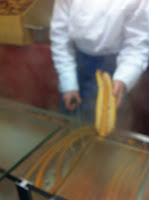So without further ado here is the first post of my much-awaited (by me at least) series on Christmas Markets in Europe. I hope you enjoy and find it useful. :)
-------------------------------------------------------
Germans know how to celebrate! This is an indisputable fact. From their winter markets to spring Easter egg sales, summer music festivals, and the ever famous Oktoberfest, and fall wine festivals- there is always a reason to get out, enjoy the countryside and celebrate. Of course, Christmas is no exception to their celebratory practices. Actually, they are unapologetically Christmas-y!
 |
| Bernkastel-Kues Market |
During the Christmas season, many villages and cities decorate their platz with lights, lives trees and of course the famous Christmas markets. These markets are steeped in history and alive with old traditions and new customs alike. If you find yourself in Europe in December, you mustn't miss these lovely treats. They surely will not disappoint.
History
A tradition first started in the Late Middle Ages in Germany, the first Christmas Markets started out as little more than seasonal markets designed to sell goods and add some liveliness to an otherwise long and miserable winter. These December markets specialized in local delicacies and traditional products. Some of the oldest recorded markets were first mentioned in historical records as early as 1310 in Munich, although Vienna's December market was mentioned in 1294 it wasn't a formal Christmas Market until years later.
Early Christmas Markets were usually held in the old part of town, Altstadt. Today they are still held in the town Marktplatz where they have large pedestrian zones and space to accommodate anywhere from 80 stalls to over 300 stalls. What once started as a seasonal market still serves the towns as a way to purchase traditional seasonal items, and gather with friends to share in good food and good Christmas cheer.
What to Expect
While no two Christmas Markets are alike, there is a pretty standard layout that most Christmas markets will traditionally follow. Let's start with the name….
I learned there are many names used for the Christmas Markets, and while they all mean Christmas Market, they aren't all used interchangeably. There is Marché de Noël and Weihnachtsmarkt which both literally translate to Christmas Market. Then there is the Christkindlmarkt or Christkindlesmarkt which translates to Christ Child Market.
Most larger markets will start the weekend before the first Sunday of Advent (December). For Americans, this means the weekend of Thanksgiving you can get your first taste of the Christmas Markets in Germany. It's great! While others are Black Friday-ing their hearts out, and potentially getting trampled to death, you can enjoy the sweet tastes of glühwein and gingerbread. A smaller village might only have a market for only one weekend in December.
The size of the market will vary greatly from city to village to town. Many of the larger cities will have markets with up to 300 stalls like the market at Dortmund, however, some markets will boast 95 stalls in their Marktplatz.
When it comes to Christmas markets, size doesn't matter. Some of the larger markets are so huge that it would require several days to explore all they have to offer, and you run the risk of many of the stalls offering similar items at slightly varying prices. For example, the Nuremberg market is so large they actually provide you with a color-coded map to help sort the food stalls from the ornament stalls and specialty stalls. In contrast to the 95 stall Trier market where you're almost assured that if you encounter something in one stall you probably won't see it in another. Which means if you like it, buy it.
 |
| Smokers! |
There are many different types of handcrafted wood ornaments, many made in the Black Forest, others handcrafted from olive wood from Bethlehem. Which by the way I think is really cool! There are also hand-blown hand-painted glass ornaments, Nativity scenes of all types of materials (wood, ceramic, tree trunks), dried flower-fruit wall hangings, toys, scarves, mittens, socks, tools made from chocolate, and
 |
| Chocolate tools |
Let's not forget the food! Food, glorious food. Oh and wine- glühwein that is. For those not familiar with glühwein it is mulled wine or spiced wine which comes in Weiss (white) or rot (red). There are also variations on the traditional glühwein, like blueberry wine or cherry wine- all great as well. For the non-alcohol variations, there is kinderpunsch or children's punch. All of these are served in unique-to-the-market mugs that you can keep as a souvenir or return and get your pfand or deposit back.
 |
| Footlong frankfurters. |
Helpful Hints
Plan, plan, plan! While Christmas Markets can be a spur of the moment day trip (if you live in Europe), some of the markets require a bit more planning, especially if you are traveling from abroad. If you a member of the Armed Forces or retiree, you can always look into a USO trip. They provide transportation and guides to get you to some of the bigger markets. For all you planners, there is a wonderful website that provides times and dates and booking information to assist you in mapping out your trip to the markets. Just remember that almost all German markets will close right before Christmas, while a few in France will remain open after Christmas until right before the New Year.
Don't forget to check back here for reviews on the several European markets I toured!
U.S. Bound
Last but never least, several U.S. cities are joining in the German Christmas Market celebrations. I haven't been to those yet, but trust and believe I will be making my rounds through the American markets soon. If you live in the Chicago area, check out their large Christkindlmarket in Daley Plaza. Here is their website with more information.
I'll keep you posted on these markets as well.
Good Luck and here's to Christmas Markets everywhere!
No comments :
Post a Comment